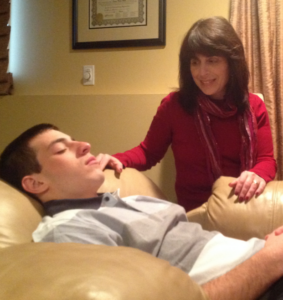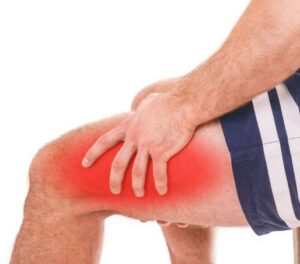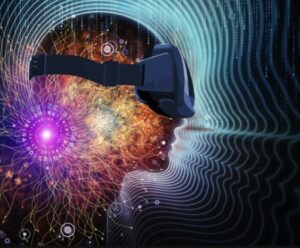
 Melissa Cipriana had no explanation left for why she couldn’t lose weight. She avoided processed foods, “white” carbohydrates and soda. She attended SoulCycle classes religiously. And she certainly had discipline: She had already lost – and kept off for years – 50 pounds through a medically supervised hCG diet, which involves eating less than 800 calories a day and receiving injections of a hormone marketed to suppress appetite.
Melissa Cipriana had no explanation left for why she couldn’t lose weight. She avoided processed foods, “white” carbohydrates and soda. She attended SoulCycle classes religiously. And she certainly had discipline: She had already lost – and kept off for years – 50 pounds through a medically supervised hCG diet, which involves eating less than 800 calories a day and receiving injections of a hormone marketed to suppress appetite.
And yet, the last 20 or 30 pounds simply wouldn’t come off. Only one possibility remained: “I knew it had everything to do with my thoughts,” says Cipriani, a 38-year-old resort CEO who splits her time between Denver and Granby, Colorado.
So Cipriani booked a session with a local hypnotherapist, whom she’d heard about through a Facebook friend and connected with via phone. “We didn’t talk about food, we didn’t talk about diet or calories in versus calories out … she was more like changing my mindset,” recalls Cipriani, who was living in New York City at the time, of her first session.
More specifically, at some sessions, Cipriani was guided into a state of deep relaxation. There, she was encouraged to discover and confront some of the mental and emotional barriers like overthinking and over-researching diet choices that had been preventing her from reaching her goals. She later integrated phrases like “I easily and effortlessly lose weight” into her psyche.
Six months later, she’d lost at least 10 pounds.”Once I broke down the barrier of ‘overthinking it’ and just accepted that I easily and effortlessly lose weight, it just came off – I knew the choices I was making were the right choices for me.” says Cipriani, who focused on eating whole foods like lean proteins, healthy fats and whole grains, and worked with a personal trainer. She eventually lost the rest of the weight and has maintained it to this day, about four years later.
Cipriani also credits hypnotherapy, which she continues to use in various forms including apps and self-hypnosis, with allowing her to meet her now-husband and cope with work stress. “I really do obviously believe [in hypnotherapy] … I have a fuller life because of it,” Cipriani says.
How Does Hypnosis Work?
Despite lingering misperceptions, hypnosis actually looks and acts a lot more like mindfulness meditation or cognitive behavioral therapy than mind control or a magic show. Like meditation, it involves getting into a  very relaxed, focused state; like CBT, it involves noticing and challenging negative thought patterns.
very relaxed, focused state; like CBT, it involves noticing and challenging negative thought patterns.
“It’s not like you’re going to get hypnotized and you’re not going to know who you are and you’re going to be made to do something by someone,” says Eric Spiegel, a clinical psychologist in the greater Philadelphia area who serves as president of the American Society of Clinical Hypnosis. “I’m going to offer you ideas and choices and let you lead the way, but I’ll kind of help you figure out the path.”
But one key characteristic that can make hypnosis work more swiftly and powerfully than more widely accepted practices is also what keeps it somewhat shrouded in mystery: It works on the subconscious level, and researchers don’t know exactly how, says David Godot, a clinical psychologist in Long Beach, California, who serves as secretary of the Society of Psychological Hypnosis, a division of the American Psychological Association.
“With hypnosis, you get into a particular state of mind where there’s a closeness between the contents of the conscious and unconscious awareness,” he explains. When you’re in it then, your conscious mind or a practitioner can offer suggestions to your subconscious mind. For example, Grace Smith, Cipriani’s Vero Beach, Florida-based hypnotherapist, might have clients looking to break unhealthy eating habits repeat, “Food is fuel. I only put the highest quality food into my body.” Occasionally, she uses “aversion therapy,” too, in order to create a negative association with a food or drink that has a deep-seeded positive association – cupcakes that used to be tied to comfort are now tied to disgust.
The idea is that by feeding these thoughts to your subconscious, you can change deeply rooted behaviors without so much conscious effort, just like you may awake from a dream with a solution to a complicated problem, or may experience a lightbulb moment while zoning out in the shower. “There’s this creative part of your mind that’s working all the time while you’re not aware of anything else,” Godot says. Through hypnosis, he adds, “that creative process can be directed to work on this particular problem.”
Proceed With Cautious Optimism
There’s some research on hypnosis for weight loss, and the results are moderately promising. One 2005 review in the International Journal of Obesity found that, taken together, the stronger studies on hypnosis for weight loss have shown that hypnotherapy leads to more dropped pounds than either cognitive behavioral therapy or dietary advice alone.
Another 2009 study concluded that hypnosis was among the only three evidence-based complementary treatments for obesity, but that if used at all, it should be used alongside tried-and-true calorie restriction and exercise. As the American Society of Clinical Hypnosis puts it, hypnosis “is of major benefit to some patients with some problems, and it is helpful with many other patients, but it can fail, just like any other clinical method.”
Whether it works for you may come down to your personality and fit with a provider, among other individual characteristics. Specifically, certain people are highly “hypnotizable” (if you easily get lost in thought or are artistically inclined, you may be one of them), and some people are especially vulnerable to suggestion under hypnosis (including people who are deemed “gullible” in conscious life), Spiegel explains. The higher you are on these traits, the faster and more effectively hypnosis will likely work, though people lower on the scales can benefit too.
You also have to truly want a particular outcome for hypnosis to work, Smith says. For example, if you say you want to quit your nighttime ice cream habit but actually love the taste and find the ritual soothing, you won’t have as much luck as someone who hates feeling compelled to eat ice cream nightly – even though he no longer enjoys it. “You need a goal [because] how much you want the result is the No. 1 thing that will dictate the results you get,” says Smith, author of the new book, “Close Your Eyes, Get Free,” which aims to make hypnosis mainstream by teaching people how to do it to themselves.
 Even if you do have a natural affinity for hypnosis and a genuine goal, finding an appropriately trained therapist who’s right for you can be complicated since there’s no single credentialing organization, state licensing rules differ (when they exist at all) and hypnotherapists may include physicians, nurses, dentists, social workers, psychologists and regular Joes. “All the time I see people who will say things like, ‘I’m a certified hypnotherapist,'” Spiegel says. “The question is, ‘OK, what are you certified in and what is your professional degree and do you have a license?'”
Even if you do have a natural affinity for hypnosis and a genuine goal, finding an appropriately trained therapist who’s right for you can be complicated since there’s no single credentialing organization, state licensing rules differ (when they exist at all) and hypnotherapists may include physicians, nurses, dentists, social workers, psychologists and regular Joes. “All the time I see people who will say things like, ‘I’m a certified hypnotherapist,'” Spiegel says. “The question is, ‘OK, what are you certified in and what is your professional degree and do you have a license?'”
Asking those questions – in addition to gauging your rapport with the potential therapist and inquiring about the hours they spent in training and in practice – is important because hypnotherapy can uncover forgotten traumatic experiences. Under the care of an unprepared provider, that experience can feel traumatic all over again rather than empowering. Godot’s rule of thumb for hypnotherapists? “Don’t use hypnosis to treat anything you wouldn’t otherwise be qualified to treat,” he says.
Good training is also important because hypnosis isn’t just about reading from a script, it’s about learning how language, pacing and tone of voice lead to the desired outcome, Spiegel says. Hypnotic suggestions or affirmations need to be positive – “I choose healthy portion sizes” rather than “I don’t overeat” – since the unconscious mind doesn’t “hear” the negative, and instead reinforces “I overeat,” says Smith, who is not a health care professional but became certified by several organizations including the International Hypnosis Federation before launching her own hypnotherapy training school.
Finally, the therapist’s philosophy matters since professionals differ, for instance, on whether it’s harmful or hurtful to instill beliefs that foods are “good” or “bad.” While Smith finds those types of mantras help break associations that are no longer helpful, other hypnotherapists like those at NY Health Hypnosis and Integrative Therapy in Manhattan do the opposite for people trying to lose weight or overcome eating disorders. “The goal is not just to end the addiction, but also to stop viewing food in terms of good and bad so that a person gets out of the cycle of overindulging and self-blame,” the therapists say on their website. Here too, knowing what resonates with you matters.
All caveats considered, health professionals say hypnosis can be powerful for life-long behavior change and no more risky than meditation or yoga. “Hypnosis is not some magical practice that is to be feared,” Godot says. “It’s just a set of techniques and tools to get closer to understanding … what’s happening in the mind.”
By: Anna Medaris Miller, Staff Writer
 As lawmakers debate on bills that could impact the opioid crisis in Tennessee, people have been looking for alternative treatments to help with chronic pain and, in many cases, addiction.
As lawmakers debate on bills that could impact the opioid crisis in Tennessee, people have been looking for alternative treatments to help with chronic pain and, in many cases, addiction.
Steve Olson has been taking individual and group clinical hypnosis sessions at the Osher Center for Integrative Medicine on West End in Nashville.
Olson has been dealing with neuropathy for the last five years. He described the extreme pain to his thighs as a baseball bat hitting him.
“I cannot even sleep with a bed sheet on my legs because the weight of a bed sheet would be extremely painful, so I would sleep on top of the bed,” Olson told NewsChannel 5. He was active and had a job, but the pain was so unbearable that Olson had to quit and rely on heavy amounts of drugs, including muscle relaxers.
He showed us nearly three pages of medications he had to take. At least one doctor wanted to increase his dosage. “Percocet was seven to eight times a day, and sometimes ten times a day. Morphine was three to four a day. I would basically sit in the chair and stare at the television and sit there and cry for hours,” recalled Olson.
Tennessee is one of the states with the highest number of opioid prescriptions per person, according to the Centers for Disease Control and  Prevention. Alabama, Mississippi, and Arkansas also join the list.
Prevention. Alabama, Mississippi, and Arkansas also join the list.
In January, Governor Bill Haslam proposed an aggressive and comprehensive plan to end the opioid epidemic in the state with three major components, including the legislature addressing prevention by limiting the supply and the dosage of opioid prescriptions.
The 66-year-old Franklin resident even went through at least a dozen doctors and different hospitals for the pain before landing at OCIM.
Dr. Lindsey McKernan helped guide him to a better place and move away from the opioids through hypnosis. “It’s a treatment that focuses between a patient and a provider, and it can be done in a group and an individual setting. It’s about learning a way to relax very deeply where you’re guided into that by a provider,” said McKernan.
She said hypnosis can help reduce the activity of signals firing back and forth between the brain and body when the person is experiencing pain. “It might not be the pain goes completely away, but it could be that your daily pain changes to seven out of ten to five out of ten. That could make the difference between getting out of bed for the day,” added McKernan.
 McKernan emphasized that hypnosis is not what is perceived in Hollywood. It is a method that allows her to relax the brain through “suggestions” and make changes in emotions, mood, thoughts, or how you feel in certain parts of your body. “I think it’s helping me learn to cope with the pain and learn how to live life again,” said Olson.
McKernan emphasized that hypnosis is not what is perceived in Hollywood. It is a method that allows her to relax the brain through “suggestions” and make changes in emotions, mood, thoughts, or how you feel in certain parts of your body. “I think it’s helping me learn to cope with the pain and learn how to live life again,” said Olson.
McKernan started the clinic hypnosis program 18 months ago with a four-hour a week clinic before transitioning to group sessions. The center went from treating four patients to 30 plus every week with a bigger team.
It’s part of research determining the effects of the group program to help with pain and quality of life aspects and how that compares to individual hypnosis. The research will last for another year.
Hypnosis services are covered by most insurances, and if they are done by a trainee under supervision, it is a free service. Most of the clinical services at OCIM are insurance-based, including mindfulness classes. The center’s movement classes (yoga, tai chi), acupuncture, and massage are fee-for-service.
By: Matthew Torres

 Hypnosis has become a common medical tool, used to reduce pain, help people stop smoking and cure them of phobias. But scientists have long argued about whether the hypnotic “trance” is a separate neurophysiological state or simply a product of a hypnotized person’s expectations.
Hypnosis has become a common medical tool, used to reduce pain, help people stop smoking and cure them of phobias. But scientists have long argued about whether the hypnotic “trance” is a separate neurophysiological state or simply a product of a hypnotized person’s expectations.
A study published on Thursday by Stanford researchers offers some evidence for the first explanation, finding that some parts of the brain function differently under hypnosis than during normal consciousness.
The study was conducted with functional magnetic resonance imaging, a scanning method that measures blood flow in the brain. It found changes in activity in brain areas that are thought to be involved in focused attention, the monitoring and control of the body’s functioning, and the awareness and evaluation of a person’s internal and external environments.
“I think we have pretty definitive evidence here that the brain is working differently when a person is in hypnosis,” said Dr. David Spiegel, a professor of psychiatry and behavioral sciences at Stanford who has studied the effectiveness of hypnosis. Functional imaging is a blunt instrument and the findings can be difficult to interpret, especially when a study is looking at activity levels in many brain areas.
professor of psychiatry and behavioral sciences at Stanford who has studied the effectiveness of hypnosis. Functional imaging is a blunt instrument and the findings can be difficult to interpret, especially when a study is looking at activity levels in many brain areas.
Still, Dr. Spiegel said, the findings might help explain the intense absorption, lack of self-consciousness and suggestibility that characterize the hypnotic state.
He said one particularly intriguing finding was that hypnotized subjects showed decreased interaction between a region deep in the brain that is active in self-reflection and daydreaming and areas of the prefrontal cortex involved in planning and executing tasks.
That decreased interaction, Dr. Spiegel said, suggested an explanation for the lack of self-consciousness shown by hypnotized subjects. “That’s why the stage hypnotist can get a football coach to dance like a ballerina without feeling self-conscious about what he’s doing,” Dr. Spiegel said. He added that it might also explain, at least in part, why hypnosis is an effective tool in psychotherapy for getting people to look at a problem in a new way.
 The researchers screened more than 500 potential subjects for susceptibility to hypnosis and then compared brain activity in 36 who scored very highly on tests measuring susceptibility to hypnosis and 21 who had very low scores on those tests.
The researchers screened more than 500 potential subjects for susceptibility to hypnosis and then compared brain activity in 36 who scored very highly on tests measuring susceptibility to hypnosis and 21 who had very low scores on those tests.
Brain activity during hypnosis was also compared with activity during resting periods and during a memory task, for both high and low susceptibility groups.
In the hypnosis task, the subjects were guided through two guided procedures for hypnotic inductions: in one, they were instructed to imagine a time when they felt happiness; in the other, they were told to remember or imagine a vacation.
All the subjects were asked in the study to rate how deeply hypnotized they felt during the inductions. Although some researchers continue to argue that hypnosis is a state produced by people’s expectations, not by biology, Dr. Spiegel said, “At some point, I just think it becomes a kind of self-fulfilling word game. I see hypnosis as a kind of app you haven’t used on your cellphone,” he said. “It’s got all kinds of capacity that people are just figuring out how to use, but if you haven’t used it the phone doesn’t do that.”
By: Erica Goode

 Some argue that hypnosis is just a trick. Others, however, see it as bordering on the paranormal – mysteriously transforming people into mindless robots. Now our recent review of a number of research studies on the topic reveals it is actually neither. Hypnosis may just be an aspect of normal human behavior.
Some argue that hypnosis is just a trick. Others, however, see it as bordering on the paranormal – mysteriously transforming people into mindless robots. Now our recent review of a number of research studies on the topic reveals it is actually neither. Hypnosis may just be an aspect of normal human behavior.
Hypnosis refers to a set of procedures involving an induction – which could be fixating on an object, relaxing or actively imagining something – followed by one or more suggestions, such as “You will be completely unable to feel your left arm”.
The purpose of the induction is to induce a mental state in which participants are focused on instructions from the experimenter or therapist, and are not distracted by everyday concerns. One reason why hypnosis is of interest to scientists is that participants often report that their responses feel automatic or outside their control.
Most inductions produce equivalent effects. But inductions aren’t actually that important. Surprisingly, the success of hypnosis doesn’t rely on special abilities of the hypnotist either – although building rapport with them will certainly be valuable in a therapeutic context.
Rather, the main driver for successful hypnosis is one’s level of “hypnotic suggestibility”. This is a term which describes how responsive we are to suggestions. We know that hypnotic suggestibility doesn’t change over time and is heritable. Scientists have even found that people with certain gene variants are more suggestible.
Most people are moderately responsive to hypnosis. This means they can have vivid changes in behavior and experience in response  to hypnotic suggestions. By contrast, a small percentage (around 10-15%) of people are mostly non-responsive. But most research on hypnosis is focused on another small group (10-15%) who are highly responsive.
to hypnotic suggestions. By contrast, a small percentage (around 10-15%) of people are mostly non-responsive. But most research on hypnosis is focused on another small group (10-15%) who are highly responsive.
In this group, suggestions can be used to disrupt pain, or to produce hallucinations and amnesia. Considerable evidence from brain imaging reveals that these individuals are not just faking or imagining these responses.
Indeed, the brain acts differently when people respond to hypnotic suggestions than when they imagine or voluntarily produce the same responses. Preliminary research has shown that highly suggestible individuals may have unusual functioning and connectivity in the prefrontal cortex.
This is a brain region that plays a critical role in a range of psychological functions including planning and the monitoring of one’s mental states. There is also some evidence that highly suggestible individuals perform more poorly on cognitive tasks known to depend on the prefrontal cortex, such as working memory.
However, these results are complicated by the possibility that there might be different sub types of highly suggestible individuals. These neurocognitive differences may lend insights into how highly suggestible individuals respond to suggestions: they may be more responsive because they’re less aware of the intentions underlying their responses.
 For example, when given a suggestion to not experience pain, they may suppress the pain but not be aware of their intention to do so. This may also explain why they often report that their experience occurred outside their control. Neuroimaging studies have not as yet verified this hypothesis but hypnosis does seem to involve changes in brain regions involved in monitoring of mental states, self-awareness and related functions.
For example, when given a suggestion to not experience pain, they may suppress the pain but not be aware of their intention to do so. This may also explain why they often report that their experience occurred outside their control. Neuroimaging studies have not as yet verified this hypothesis but hypnosis does seem to involve changes in brain regions involved in monitoring of mental states, self-awareness and related functions.
Although the effects of hypnosis may seem unbelievable, it’s now well accepted that beliefs and expectations can dramatically impact human perception. It’s actually quite similar to the placebo response, in which an ineffective drug or therapeutic treatment is beneficial purely because we believe it will work. In this light, perhaps hypnosis isn’t so bizarre after all. Seemingly sensational responses to hypnosis may just be striking instances of the powers of suggestion and beliefs to shape our perception and behavior. What we think will happen morphs seamlessly into what we ultimately experience.
Hypnosis requires the consent of the participant or patient. You cannot be hypnotized against your will and, despite popular misconceptions, there is no evidence that hypnosis could be used to make you commit immoral acts against your will.
Hypnosis as medical treatment
Meta-analyses, studies that integrate data from many studies on a specific topic, have shown that hypnosis works quite well when it comes to treating certain conditions. These include irritable bowel syndrome and chronic pain. But for other conditions, however, such as smoking, anxiety, or post-traumatic stress disorder, the evidence is less clear cut – often because there is a lack of reliable research.
But although hypnosis can be valuable for certain conditions and symptoms, it’s not a panacea. Anyone considering seeking hypnotherapy should do so only in consultation with a trained professional. Unfortunately, in some countries, including the UK, anyone can legally present themselves as a hypnotherapist and start treating clients. However, anyone using hypnosis in a clinical or therapeutic context needs to have conventional training in a relevant discipline, such as clinical psychology, medicine, or dentistry to ensure that they are sufficiently expert in that specific area.
should do so only in consultation with a trained professional. Unfortunately, in some countries, including the UK, anyone can legally present themselves as a hypnotherapist and start treating clients. However, anyone using hypnosis in a clinical or therapeutic context needs to have conventional training in a relevant discipline, such as clinical psychology, medicine, or dentistry to ensure that they are sufficiently expert in that specific area.
We believe that hypnosis probably arises through a complex interaction of neurophysiological and psychological factors – some described here and others unknown. It also seems that these vary across individuals.
But as researchers gradually learn more, it has become clear that this captivating phenomenon has the potential to reveal unique insights into how the human mind works. This includes fundamental aspects of human nature, such as how our beliefs affect our perception of the world and how we come to experience control over our actions.
By: Devin Terhune and Steven Jay Lynn

An easy, effective way to control how you feel and enhance success with your goals. [
contact]

 Melissa Cipriana had no explanation left for why she couldn’t lose weight. She avoided processed foods, “white” carbohydrates and soda. She attended SoulCycle classes religiously. And she certainly had discipline: She had already lost – and kept off for years – 50 pounds through a medically supervised hCG diet, which involves eating less than 800 calories a day and receiving injections of a hormone marketed to suppress appetite.
Melissa Cipriana had no explanation left for why she couldn’t lose weight. She avoided processed foods, “white” carbohydrates and soda. She attended SoulCycle classes religiously. And she certainly had discipline: She had already lost – and kept off for years – 50 pounds through a medically supervised hCG diet, which involves eating less than 800 calories a day and receiving injections of a hormone marketed to suppress appetite. very relaxed, focused state; like CBT, it involves noticing and challenging negative thought patterns.
very relaxed, focused state; like CBT, it involves noticing and challenging negative thought patterns. Even if you do have a natural affinity for hypnosis and a genuine goal, finding an appropriately trained therapist who’s right for you can be complicated since there’s no single credentialing organization, state licensing rules differ (when they exist at all) and hypnotherapists may include physicians, nurses, dentists, social workers, psychologists and regular Joes. “All the time I see people who will say things like, ‘I’m a certified hypnotherapist,'” Spiegel says. “The question is, ‘OK, what are you certified in and what is your professional degree and do you have a license?'”
Even if you do have a natural affinity for hypnosis and a genuine goal, finding an appropriately trained therapist who’s right for you can be complicated since there’s no single credentialing organization, state licensing rules differ (when they exist at all) and hypnotherapists may include physicians, nurses, dentists, social workers, psychologists and regular Joes. “All the time I see people who will say things like, ‘I’m a certified hypnotherapist,'” Spiegel says. “The question is, ‘OK, what are you certified in and what is your professional degree and do you have a license?'” As lawmakers debate on bills that could impact the opioid crisis in Tennessee, people have been looking for alternative treatments to help with chronic pain and, in many cases, addiction.
As lawmakers debate on bills that could impact the opioid crisis in Tennessee, people have been looking for alternative treatments to help with chronic pain and, in many cases, addiction. Prevention. Alabama, Mississippi, and Arkansas also join the list.
Prevention. Alabama, Mississippi, and Arkansas also join the list. McKernan emphasized that hypnosis is not what is perceived in Hollywood. It is a method that allows her to relax the brain through “suggestions” and make changes in emotions, mood, thoughts, or how you feel in certain parts of your body. “I think it’s helping me learn to cope with the pain and learn how to live life again,” said Olson.
McKernan emphasized that hypnosis is not what is perceived in Hollywood. It is a method that allows her to relax the brain through “suggestions” and make changes in emotions, mood, thoughts, or how you feel in certain parts of your body. “I think it’s helping me learn to cope with the pain and learn how to live life again,” said Olson.
 Hypnosis has become a common medical tool, used to reduce pain, help people stop smoking and cure them of phobias. But scientists have long argued about whether the hypnotic “trance” is a separate neurophysiological state or simply a product of a hypnotized person’s expectations.
Hypnosis has become a common medical tool, used to reduce pain, help people stop smoking and cure them of phobias. But scientists have long argued about whether the hypnotic “trance” is a separate neurophysiological state or simply a product of a hypnotized person’s expectations. professor of psychiatry and behavioral sciences at Stanford who has studied the effectiveness of hypnosis. Functional imaging is a blunt instrument and the findings can be difficult to interpret, especially when a study is looking at activity levels in many brain areas.
professor of psychiatry and behavioral sciences at Stanford who has studied the effectiveness of hypnosis. Functional imaging is a blunt instrument and the findings can be difficult to interpret, especially when a study is looking at activity levels in many brain areas. The researchers screened more than 500 potential subjects for susceptibility to hypnosis and then compared brain activity in 36 who scored very highly on tests measuring susceptibility to hypnosis and 21 who had very low scores on those tests.
The researchers screened more than 500 potential subjects for susceptibility to hypnosis and then compared brain activity in 36 who scored very highly on tests measuring susceptibility to hypnosis and 21 who had very low scores on those tests.
 Some argue that hypnosis is just a trick. Others, however, see it as bordering on the paranormal – mysteriously transforming people into mindless robots. Now our recent review of a number of research studies on the topic reveals it is actually neither. Hypnosis may just be an aspect of normal human behavior.
Some argue that hypnosis is just a trick. Others, however, see it as bordering on the paranormal – mysteriously transforming people into mindless robots. Now our recent review of a number of research studies on the topic reveals it is actually neither. Hypnosis may just be an aspect of normal human behavior. to hypnotic suggestions. By contrast, a small percentage (around 10-15%) of people are mostly non-responsive. But most research on hypnosis is focused on another small group (10-15%) who are highly responsive.
to hypnotic suggestions. By contrast, a small percentage (around 10-15%) of people are mostly non-responsive. But most research on hypnosis is focused on another small group (10-15%) who are highly responsive. For example, when given a suggestion to not experience pain, they may suppress the pain but not be aware of their intention to do so. This may also explain why they often report that their experience occurred outside their control. Neuroimaging studies have not as yet verified this hypothesis but hypnosis does seem to involve changes in brain regions involved in monitoring of mental states, self-awareness and related functions.
For example, when given a suggestion to not experience pain, they may suppress the pain but not be aware of their intention to do so. This may also explain why they often report that their experience occurred outside their control. Neuroimaging studies have not as yet verified this hypothesis but hypnosis does seem to involve changes in brain regions involved in monitoring of mental states, self-awareness and related functions. should do so only in consultation with a trained professional. Unfortunately, in some countries, including the UK, anyone can legally present themselves as a hypnotherapist and start treating clients. However, anyone using hypnosis in a clinical or therapeutic context needs to have conventional training in a relevant discipline, such as clinical psychology, medicine, or dentistry to ensure that they are sufficiently expert in that specific area.
should do so only in consultation with a trained professional. Unfortunately, in some countries, including the UK, anyone can legally present themselves as a hypnotherapist and start treating clients. However, anyone using hypnosis in a clinical or therapeutic context needs to have conventional training in a relevant discipline, such as clinical psychology, medicine, or dentistry to ensure that they are sufficiently expert in that specific area.








